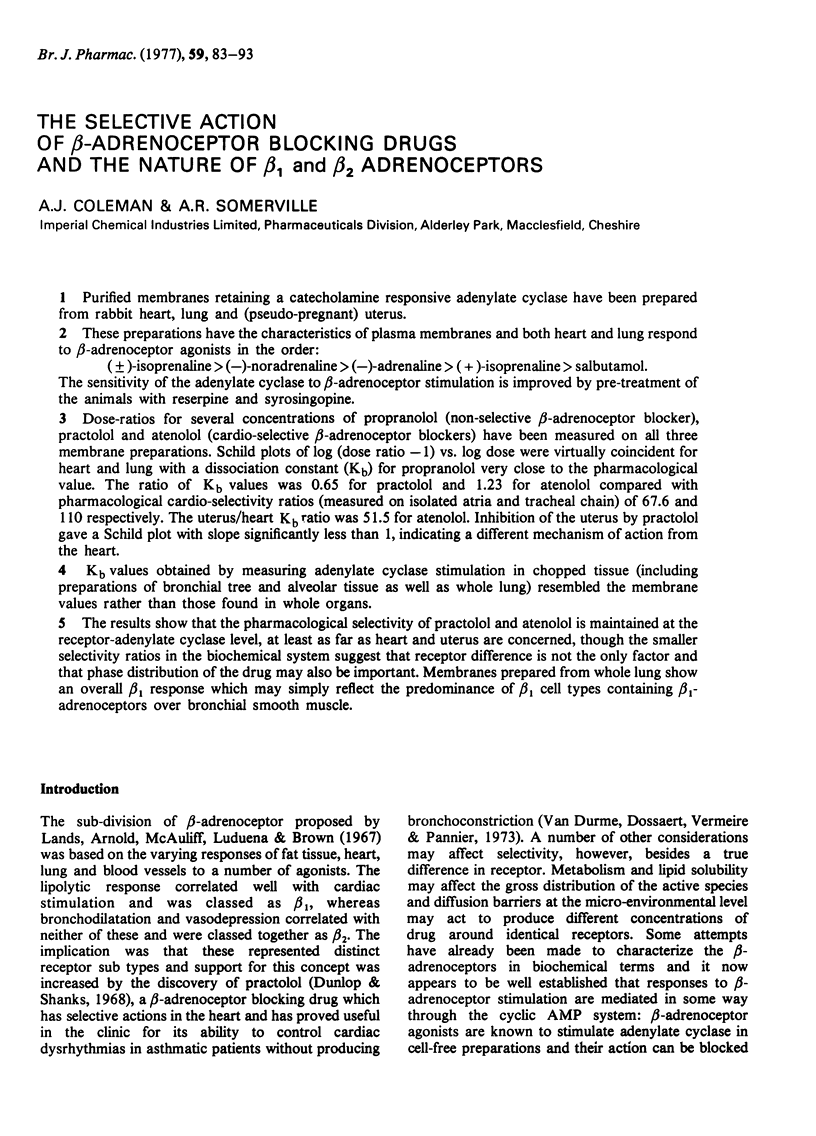Abstract
1 Purified membranes retaining a catecholamine responsive adenylate cyclase have prepared from rabbit heart, lung and (pseudo-pregnant) uterus. 2 These preparations have the characteristics of plasma membranes and both heart and lung respond to beta-adrenoceptor agonists in the order: (+/-)-isoprenaline greater than (-)-noradrenaline greater than (-)-adrenaline greater than (+)-isoprenaline greater than salbutamol. The sensitivity of the adenylate cyclase to beta-adrenoceptor stimulation is improved by pre-treatment of the animals with reserpine and syrosingopine. 3 Dose-ratios for several concentrations of propranolol (non-selective beta-adrenoceptor blocker), practolol and atenolol (cardio-selective beta-adrenoceptor blockers) have been measured on all three membrane preparations. Schild plots of log (dose ratio -1) vs. log dose were virtually coincident for heart and lung with a dissociation constant (Kb) for propranolol very close to the pharmacological value. The ratio of Kb values was 0.65 for practolol and 1.23 for atenolol compared with pharmacological cardio-selectivity ratios (measured on isolated atria and tracheal chain) of 67.6 and 110 respectively. The uterus/heart Kb ratio was 51.5 for atenolol. Inhibition of the uterus by practolol gave a Schild plot with slope significantly less than 1, indicating a different mechanism of action from the heart. 4 Kb values obtained by measuring adenylate cyclase stimulation in chopped tissue (including preparations of bronchial tree and alveolar tissue as well as whole lung) resembled the membrane values rather than those found in whole organs. 5 The results show that the pharmacological selectivity of practolol and atenolol is maintained at the receptor-adenylate cyclase level, at least as far as heart and uterus are concerned, though the smaller selectivity ratios in the biochemical system suggest that receptor differences is not the only factor and that phase distribution of the drug may also be important. Membranes prepared from whole lung show that phase distribution of the drug may also be important. Membranes prepared from whole lung show an overall beta1 response which may simply reflect the predominance of beta1 cell types containing beta1-adrenoceptors over bronchial smooth muscle.
Full text
PDF










Selected References
These references are in PubMed. This may not be the complete list of references from this article.
- Avruch J., Wallach D. F. Preparation and properties of plasma membrane and endoplasmic reticulum fragments from isolated rat fat cells. Biochim Biophys Acta. 1971 Apr 13;233(2):334–347. doi: 10.1016/0005-2736(71)90331-2. [DOI] [PubMed] [Google Scholar]
- Barrett A. M., Carter J., Fitzgerald J. D., Hull R., Le Count D. A new type of cardioselective adrenoceptive blocking drug. Br J Pharmacol. 1973 Jun;48(2):340P–340P. [PMC free article] [PubMed] [Google Scholar]
- Birnbaumer L. Hormone-sensitive adenylyl cyclases. Useful models for studying hormone receptor functions in cell-free systems. Biochim Biophys Acta. 1973 Sep 10;300(2):129–158. doi: 10.1016/0304-4157(73)90002-6. [DOI] [PubMed] [Google Scholar]
- Brown B. L., Albano J. D., Ekins R. P., Sgherzi A. M. A simple and sensitive saturation assay method for the measurement of adenosine 3':5'-cyclic monophosphate. Biochem J. 1971 Feb;121(3):561–562. doi: 10.1042/bj1210561. [DOI] [PMC free article] [PubMed] [Google Scholar]
- Burges R. A., Blackburn K. J. Adenyl cyclase and the differentiation of -adrenoreceptors. Nat New Biol. 1972 Feb 23;235(60):249–250. doi: 10.1038/newbio235249a0. [DOI] [PubMed] [Google Scholar]
- Chasin M., Mamrak F., Samaniego S. G. Preparation and properties of a cell-free, hormonally responsive adenylate cyclase from guinea pig brain. J Neurochem. 1974 Jun;22(6):1031–1038. doi: 10.1111/j.1471-4159.1974.tb04333.x. [DOI] [PubMed] [Google Scholar]
- Dunlop D., Shanks R. G. Selective blockade of adrenoceptive beta receptors in the heart. Br J Pharmacol Chemother. 1968 Jan;32(1):201–218. doi: 10.1111/j.1476-5381.1968.tb00444.x. [DOI] [PMC free article] [PubMed] [Google Scholar]
- Ganser A. L., Forte J. G. K + -stimulated ATPase in purified microsomes of bullfrog oxyntic cells. Biochim Biophys Acta. 1973 Apr 25;307(1):169–180. doi: 10.1016/0005-2736(73)90035-7. [DOI] [PubMed] [Google Scholar]
- Giles R. E., Williams J. C., Finkel M. P. The bronchodilator and cardiac stimulant effects of Thll65a, salbutamol and isoproterenol. J Pharmacol Exp Ther. 1973 Sep;186(3):472–481. [PubMed] [Google Scholar]
- Krishna G., Weiss B., Brodie B. B. A simple, sensitive method for the assay of adenyl cyclase. J Pharmacol Exp Ther. 1968 Oct;163(2):379–385. [PubMed] [Google Scholar]
- LOWRY O. H., ROSEBROUGH N. J., FARR A. L., RANDALL R. J. Protein measurement with the Folin phenol reagent. J Biol Chem. 1951 Nov;193(1):265–275. [PubMed] [Google Scholar]
- Lands A. M., Arnold A., McAuliff J. P., Luduena F. P., Brown T. G., Jr Differentiation of receptor systems activated by sympathomimetic amines. Nature. 1967 May 6;214(5088):597–598. doi: 10.1038/214597a0. [DOI] [PubMed] [Google Scholar]
- Lefkowitz R. J. Heterogeneity of adenylate cyclase-coupled beta-adrenergic receptors. Biochem Pharmacol. 1975 Mar 1;24(5):583–590. doi: 10.1016/0006-2952(75)90178-1. [DOI] [PubMed] [Google Scholar]
- Mayer S. E. Effects of adrenergic agonists and antagonists on adenylate cyclase activity of dog heart and liver. J Pharmacol Exp Ther. 1972 Apr;181(1):116–125. [PubMed] [Google Scholar]
- SCHILD H. O. Drug antagonism and pAx. Pharmacol Rev. 1957 Jun;9(2):242–246. [PubMed] [Google Scholar]
- Van Durme J. P., Bossaert L., Vermeire P., Pannier R. Practolol in treating tachyarrhythmias. Am Heart J. 1973 Aug;86(2):284–285. doi: 10.1016/0002-8703(73)90262-7. [DOI] [PubMed] [Google Scholar]


